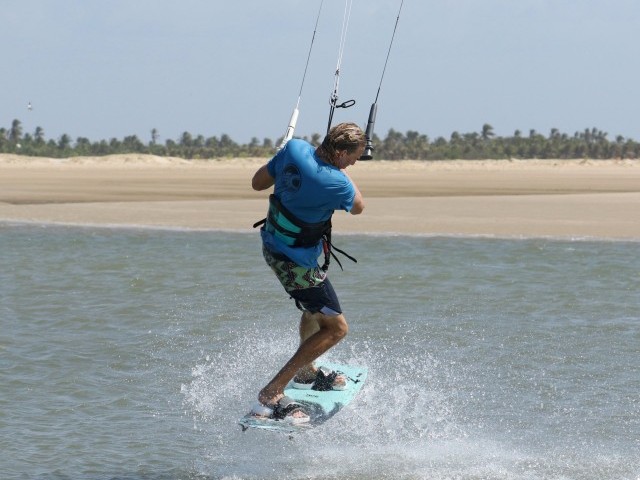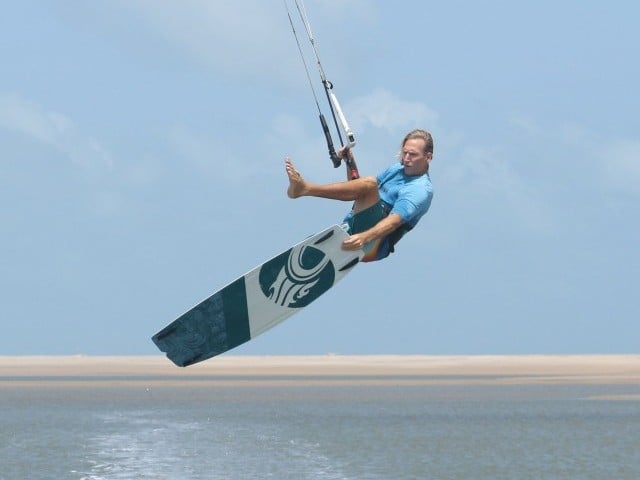
Back Roll Nose Grab Down Loop Transition
Technique / Intermediate
Introduction
Last issue we very much lauded rotations, we’re not shy to praise a grab or two, whilst our undying love for transitions is anything but a secret. Our fondness for killer combos is shared by many, and when you can squeeze all three bears into one move it’s the holy trinity of practicality, style and downright dynamite. The only enduring negative of such unions remains a suspect name that doesn’t quite slip off the tongue, but seeing as how it’s about doing it, not shouting it, we’re all good.
The Back Roll Nose Grab Down Loop Transition is a veritable beauty, which looks quite lovely and feels exquisite. Base moves and prerequisites for this are a nose grab back roll, and if you’ve got a back roll down loop transition in the bag it will be useful, but at the very least a back roll and a down loop air gybe are essential, even for those with oodles of confidence. Although you’ll have time in the air, this move requires pinpoint control of your take off to put all the required pieces together and make it achievable. As we so often do, let’s work through the separate parts that’ll stuff this one well and truly into your bag of tricks.
Your approach for this should be as for any practiced aerial downloop transition. You will want height, you will want to downloop in the air post rotation and you’ll expect a fair bit of pull. As such you should be happy carrying a little bit of speed into this, more than for a straight transition and a touch less than for a jump. This means a decent edge, bum low, back leg stiff and kite around 1 or 11 o’clock. This will give you control of both the board and the kite and puts you in a good place from which to start.
Take Off Pic A.
The absolute essence of every move. This really is the busy bit. On your to do list are, extend up and away from the kite to get maximum tension, generate your rotation and control position of kite. All completed in a manner that sets you up for the grab ahead! A good positive but short send of the kite will give you the lift you crave and will stop the kite travelling too far back in the window. Letting the bar follow the sweet spot out as you send the kite will allow you to hold you edge for longer. As you send the kite with a decent push/pull on the bar carve upwind to initiate your back roll. Once you’re carving and you have lift from the kite, level the bar, stamp off against your back heel and pull the bar in. You can see that Karine is fully extended, having kicked off hard, bar is level, so she’s stopped sending it and she’s pulled in. However, the crux of the move and photo is that her head is still looking forwards, it’s not looking into the rotation. You want the slowest rotation possible, so trust your edge and keep focused on your centre line.
Kite and Dangle Pic B.
It’s not often that you’ll hear us encourage wobbly legs in a sent jump, but here we will. Normally it’s a case of rushing to get your knees up, fighting your abs, convincing them that this is their purpose on the planet, to ignore gravity and pain and to get the board up on the double. Seeing as how the goal is to sneak in a cheeky nose grab, leaving your back leg as straight as a Roman road post stamp is exactly what you want, so kick for the Empire and leave it there. This will make the grab easier. Continuing on from the last point, as you gain altitude you should be aiming to get the bar as level as possible whilst you still have two hands for the job. Looking at Karine, her back leg is straight as a die and her bar would have the bubble in the middle. One last observation, Karine is still staring at her centre line!
Release, Reach, Extend and Bend Pic C.
There you have it. With the kite under control and a slow rotation in motion you can go for the grab. As Karine shows here, release your back hand and reach towards the nose of the board. She’s still got her rear leg extended, no bend in the knee. And finally, she’s lifting her front knee towards her. Karine is also looking at the nose of her board. As well as improving your aim, this also puts you in a better position for the grab, keeping you in a look-back position, behind the bar, whilst also keeping your rotation slow, almost stalled. Looking good.
The Money Shot Pic D.
Once you’ve got the grab, hold it tight and do very little else. You can see how in terms of her rotation, Karine has the grab quite early. However, this is more due to the fact that she’s creeping round in the slowest of mo. Any quicker and she’d miss the grab. She keeps the bar in for support and focuses her eyes behind her. In this position you are stalling, hitting the pause button and enjoying the moment. The great thing is, that even if the kite drifts a bit too far forward, it doesn’t really matter as you’ll be downlooping anyway!
Timing Pic E.
Assuming that you won the slow rotation prize, the only reason to stop and ponder landing is altitude. You can keep holding, longer and longer the more height you add to this, as you’ll actually use your landing, the subsequent downloop to help you finish your rotation. However, once you’re Earthbound and floating down it’s time to move on to the next step, otherwise you might miss the opportunity to set your downloop in motion. In the picture, and it’s more noticeable in the following sequence, Karine starts to drop and immediately releases her grab, whilst steering the kite forwards with a bit more meaning. She doesn’t look forwards yet.
Even More Meaning Pic F.
Your objective with a downloop is to get the kite looping forwards just early enough that you get the pull in the air a moment before landing. Any earlier and it’ll drop you if it completes the loop, any later and you’ll have no speed until after you’ve landed. The trick to any downloop is to get the kite looping from the side of the window in front of your present direction of travel, so here for Karine to her left. Hence the reason she steered the kite with more meaning in the previous pic. To make sure that her kite was in front of 12 o’clock, on the way to 11 o’clock in her case. From here the kite will pull you forwards and down wind. If it’s only at 12, it’ll loop forwards but end up behind you and give you no pull through. Now that it’s in front you want it to go, so all (both) hands on deck. Karine uses a decent push/pull to get the kite looping without stalling.
Head, Shoulders, Knees & Toes Pic G.
As the ditty goes, it could well have been penned by a kiter. You need to anticipate where the pull will come from and get yourself ready. Best practice is to start with your head. Look where you will be going, from where the pull will come. If you asked the kite the right question it should be pulling you forwards, just like a hefty dive would, but the kite will continue and head back the other way. As your head looks towards your mythical landing pad allow the rest of the body to follow, open the shoulders and then forcefully bring your knees through, allowing the new front foot, toes and all to point the board off the wind for a soft landing. Karine has the kite arcing through the down loop, she’s looking where she’ll go and has brought her new front foot, her right foot through, so that she can land downwind, before carving back onto her edge in the new direction:)
Top Tips
Same bi-monthly words of wisdom and encouragement apply. Break this down into steps to get comfy with the movements and conditions. Slow back roll is your first challenge. Slow back roll transition with a downloop is the next. Slow back roll with a nose grab and then it’s all systems go and the killer combo attempt. Being competent at each step will guarantee success.
Now scan through the sequence and study the videos to see the move in all its glory.
Common Problems
Before anything else, the most likely issue once you start to link together all the parts will be missing the grab. It’s a natural symptom of rushing everything that you can already do much slower, because you’re thinking ahead. If you’re worried about the grab before you’ve left the water, there’s a good chance your take off won’t be ideal. Concentrate on keeping the bar on the sweet spot, even if you’re following it out. It’s quite likely that as you attempt to multitask you will let the bar out too much as the kite lifts. It’ll then fly too far back, you’ll be pulled away from the nose and it’s game over.
Not getting any oomph from down loop. Purely a matter of not flying the kite forwards whilst grabbing. Two solutions, try a shorter send, so that the kite stops just as it passes 12 o’clock. If you’re happy with your send and you’re trying to get higher, make sure that you drift the kite forwards whilst grabbing, so that it’s on the T and primed to go once you give it the imperative.
Keystones
- Comfortable speed, short and sharp send
- Solid stamp, no head
- Legs straight, level bar
- Release, reach, extend and bend
- Drop grab, steer kite forward, meaningful loop, anticipate pull, new foot forward.
This technique article was in Issue 80 of IKSURFMAG.
Related
By Christian and Karine
Christian and Karine have been working together as a coaching team, running improver to advanced kitesurfing clinics since 2003.





























